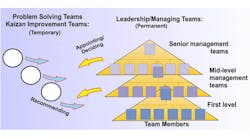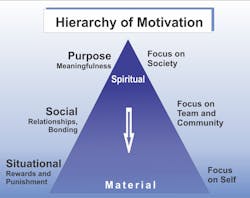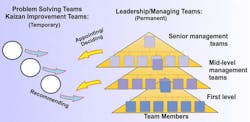The Toyota Production System or lean management has been described in many ways. It is the systematic elimination of waste. It is continuous improvement. It is striving for interruption-free processes. It is a passionate focus on serving customers. It is many things. But one aspect of lean that has not been given enough attention, in my opinion, is how lean is an organization wide system of motivation that creates a high-performance culture.
Too many lean implementations suffer from a focus on problem-solving skills, but a failure to attend to the system or culture of motivation. Too many rely on the "they oughtta wanna" assumption, which usually results in disappointment.
Competency x Motivation = Performance
Ultimately all organization performance comes down to human behavior, and there are always two aspects to achieving high performance: One is competence and the other is motivation. There must be competence in technical skills, and there must be competence in social skills such as teamwork and problem solving, for example. But, skills are useless unless individuals are motivated to use them. From my experience at Toyota and Honda and other high-performing organizations, there is a high degree of motivation for not only personal success, but the collective success of the group -- the team and the company. Many of those implementing lean would do well to focus more on creating a systematic approach to motivating all members of the organization.
In this article I will discuss some ways you can build this motivational culture.
Some are motivated by a higher calling and some are motivated by money. In behavioral psychology there is the idea of "multiple schedules of reinforcement." This simply means that at the same time we may be motivated by long-term career goals, a desire to serve our family, money, and social recognition by team members. Multiple things are reinforcing (or punishing) our behavior at the same time, and our behavior is a result of the net effects of these different stimuli.
Focusing on only one source motivation (or schedule of reinforcement) is a mistake. It is better to optimize all of the forms of motivation and thereby impact the most number of people who each have their own personal desires.
The job of management is to optimize all of the available sources of motivation to increase those behaviors that contribute to the success of the organization.
It is useful to think of three types or sources of motivation: purpose or meaning; social relationships, and situational rewards and punishment. You can think of these as a hierarchy from the spiritual to the material. I suggest not judging that one is better than another. If you are starving, getting a meal is very important. At different times in our life each form of motivation may be more or less important. However, I would make the value judgment that being focused only on the material or the self is a weakness. There is a great deal of research that demonstrates that we are happier human beings when we are focused on serving others, working in groups, and when we feel that our lives are achieving an ennobling purpose.
Let's look at each of these and see how they may be optimized in your organization.
The Motivation of Purpose
The spiritual is the attraction of a higher purpose, something beyond the "self" or immediate gratification. Spiritual motivation is linked to deep personal beliefs and values. Your religious faith, your family, and your country may all be sources of motivation at this spiritual level. Motives at this level are almost always focused on the very long term. You will sacrifice for achieving a goal in the afterlife. You will sacrifice much of your own pleasure for the well-being of your family. And many have willingly sacrificed their own lives for their country and their faith.
When someone sacrifices for that which they believe to be noble, we consider them more noble. Think of the last time you sacrificed your time, your energy or your money toward that which believed to be noble. How did you feel? More noble. This is the inherent mystery of sacrifice, and every great leader knows to call upon it.
There was a period of few years back when there was a lot of focus on company mission, vision and values. It even became a source of jokes or references to "that vision thing." Of course, lofty statements that are not supported by action and by aligning processes and systems will soon become meaningless. But, these statements can and should be a reference point for everything we do in the organization, just as the "right to freedom of speech, press and religion" can be a long-term and sustaining value for a country.
In health care and some other organizations that provide direct human services, it is relatively easy to understand a "higher purpose" to your work. When manufacturing products it is a bit more difficult, but the world's best manufacturers are still able to create this sense of mission or purpose.
Both Toyota and Honda have given a great deal of thought to their mission, vision and values, and they do sincerely strive to put these into practice. In each case they do provide their associates with a sense of making a contribution, doing something worthy, beyond the pursuit of personal rewards.
Toyota Global Vision
"Toyota will lead the way to the future of mobility, enriching lives around the world with the safest and most responsible ways of moving people. Through our commitment to quality, constant innovation and respect for the planet, we aim to exceed expectations and be rewarded with a smile. We will meet our challenging goals by engaging the talent and passion of people, who believe there is always a better way."
Honda Global Vision
Honda's "Fundamental Beliefs" are divided into "Respect for the Individual," which includes Equality, Initiative and Trust. And, their "Three Joys," which are all based on how different stakeholders are made to feel by the actions and products of the corporation. I think it is easy for any employee to visualize each of these joys and it answers the question, "Why are we doing this, anyway?"
Honda's Three Joys
• The Joy of Buying
The joy of buying is achieved through providing products and services that exceed the needs and expectations of each customer.
• The Joy of Selling
The joy of selling occurs when those who are engaged in selling and servicing Honda products develop relationships with a customer based on mutual trust. Through this relationship, Honda associates, dealers and distributors experience pride and joy in satisfying the customer and in representing Honda to the customer.
• The Joy of Creating
The joy of creating occurs when Honda associates and suppliers involved in the design, development, engineering and manufacturing of Honda products recognize a sense of joy in our customers and dealers. The joy of creating occurs when quality products exceed expectations and we experience pride in a job well done.
How Do You Make Use of Your Purpose?
If these statements are developed and stuck on the wall, they will soon have little meaning. Here are some ways you can employ your purpose to achieve greater motivation:
• Every communication regarding strategies and objectives should make reference to how those strategies and objectives serve to achieve the company's purpose.
• When developing strategy and objectives, the purpose should serve as a required point of reference.
• Each time executives give talks or presentations to employees, they should frame the presentation in terms of the company purpose.
• When discussing quality problems, you can refer to the purpose. For example, "How do you think this will impact the joy of selling or buying our car?"
The Motivation of Social Bonds
The United States has long been torn between the appeal of the rugged individualist and the desire for community. Much of our mythology is built around the idea of the Lone Ranger, the lone entrepreneur, or the individual (Horatio Alger) who achieves great wealth fighting against great odds.
The reality of our entrepreneurial culture is that it is built on both. The New World was settled by small Pilgrim groups who came and settled in what were essentially "communes." We moved West in wagon trains, not single wagons, and those wagon trains formed large circles at night to provide the protection of the group. And, our early history was one of farming communities who worked as a group to build barns and formed farm collectives to purchase supplies and to market their products. And, our industry started in small craft shops that were essentially family units.
One can make a good argument that we have a genetic predisposition or requirement to work in small groups. Our genetic ancestors hunting antelope on the Serengeti plains of Africa hunted in family groups, teams, and would have starved hunting alone.
Research has demonstrated that those who have close social bonds -- family, community or church -- are likely to be happier, have fewer incidents of depression, and live longer. Those who live in isolation suffer the reverse.
It is not surprising that when Henry Ford's factory broke the work down into highly specialized, individualized and isolated tasks, workers suffered depression and ultimately rebelled by self-organizing into groups in which they called each other "brothers." The cause of unionization was not just money. It was the psychological need for human bonding. A team, a union, or a gang in the inner city all serve to create a family-like unit that provides psychological safety.
The importance of the team process in the Toyota Production System has been undervalued. The work team at Toyota and Honda is equivalent to the family unit in society. It is the primary learning organization, the primary source of bonding with a group, and the primary way employees contribute to the company’s mission. The work team is the Gemba! But, many companies make the mistake of assuming that the formation of work teams is the sole solution to creating a team culture. After more than 30 years of implementing self-directed work teams, I can promise that if managers are not formed into teams, trained in the exact same team skills and processes, the team culture will not take hold. Teams must be effective at every level.
Jeff Liker and Michael Hoseus in their book Toyota Culture: The Heart and Soul of the Toyota Way well describe the importance of the work team and the team leader:
"At Toyota there are small rewards at the team level and the potential of more significant bonuses shared by everyone if the plant and company perform well. Delving deeper into the values and assumptions of the Toyota culture, we can see this approach reflects the value placed on teamwork. More broadly, Toyota wants its team members to develop the highest level of accountability and ownership and as such to understand that their fate is tied to the company." (p. 8-9)
"It is interesting that the team leader within Toyota is considered the lynch pin of TPS and few companies 'going lean' have this role... It is safe to say that the Toyota Production System would not function without high performance teams on the shop floor." (p. 228)
What defines a group of people as a high performance team? If I were to walk through your facility, I would randomly speak to employees and ask them the following questions, which define a high performing team:
• Do you have on-going responsibility for a work process that results in business revenue, operating costs or meets customer and client satisfaction requirements. What is that process?
• Do you know your customers who value your work and do you communicate with them concerning their requirements and satisfaction?
• Do you have a balanced scorecard that includes process, finance, customer satisfaction and learning or development measures?
• Do you have daily or weekly meetings in which you review your performance and solve problems?
• Do you have the responsibility to evaluate your performance, solve problems and make decisions to continuously improve your operations?
• Do you have a visual display of your team's performance?
• Has your team been coached in team skills, and have they demonstrated competence in each of the above tasks?
Situational Motivation
Situational motivation is the result of the reinforcement or punishment of behavior. Acknowledging that many of us are motivated on a personal level by various forms of recognition for our own behavior should in no way negate the importance of the previous two forms of motivation. Motivation is not a zero sum game; it is additive.
It is important to recognize that when both Honda and Toyota built plants in the United States, they both changed their systems of motivation. They both adapted the "American way" of individual initiative and the individual desire for recognition. Neither of them said, "The Japanese way is best. You Americans must adopt it."
On the contrary, they redesigned their systems to adapt to the American culture. This is an important lesson.
"Toyota has a strong philosophy of teamwork, sharing rewards and expecting people to do their best for the company. They did not want to compromise these principles when they expanded to North America. At the same time, they had to understand and respect the realities of Western culture." (p. 400) Toyota Culture.
To adapt to this culture, Toyota developed a different compensation system. "The philosophy and much of the practice of compensating salaried members is the same as for hourly employees. The base salary is approximately 75% of the total with the other 25% variable pay in the form of bonuses." (Ibid., p 407)
At Honda America Manufacturing they developed a point system, much like one I implemented in a North Carolina prison setting many years before.
One day some years back, I was visiting the Marysville plant and observed an award ceremony in which an individual employee was being awarded a Honda Civic, which he earned by accumulating individual points. The Quality Circle program, suggestion system, quality awards, and safety awards are all tied together with a point system that is awarded individually. Every associate earns points by participating in any of these improvement processes. Awards include award certificates, gift certificates, Department Manager's Award, Plant Manager's Award, and President’s Award. These also result in points accumulating over your career, and these points can earn a Honda Civic (that was for 2,500 points, at the time of my visit) and an Accord (5,000 points), plus two weeks off with pay and airplane tickets to anywhere in the world with spending money.
In addition to hourly or salaried compensation, all associates participate in profit sharing. This profit sharing is an innovation of Honda of America and is not part of the system in Japan. Ten percent of the gross profit generated by Honda Motor Co. is shared with associates based on their relative compensation. Good attendance results in another bonus.
In your organization, are there multiple ways, as at Honda, for individuals to earn both tangible and social recognition for individual efforts that contribute to the success of the company?
It Is A System - Not An Event or Accident!
A highly motivated work force is not an accident. It is not the result of being in one part of the country or another, having a union or non-union. It is the result of systematic efforts on the part of management to design and improve a system of motivation. The most effective systems optimize an ennobling purpose, the social bonds of strong teamwork, and the availability of individual incentives. They all contribute unique elements to a holistic system of motivation.
Lawrence M. Miller has been doing organizational change consulting for 35 years, beginning with his work creating a free economy in prisons. He has worked with Honda, Shell Oil, and dozens of other corporations. He is the author of 10 books, most recently Getting to Lean – Transformational Change Management. His website and blog is www.ManagementMeditations.com. He can be reached at [email protected].






